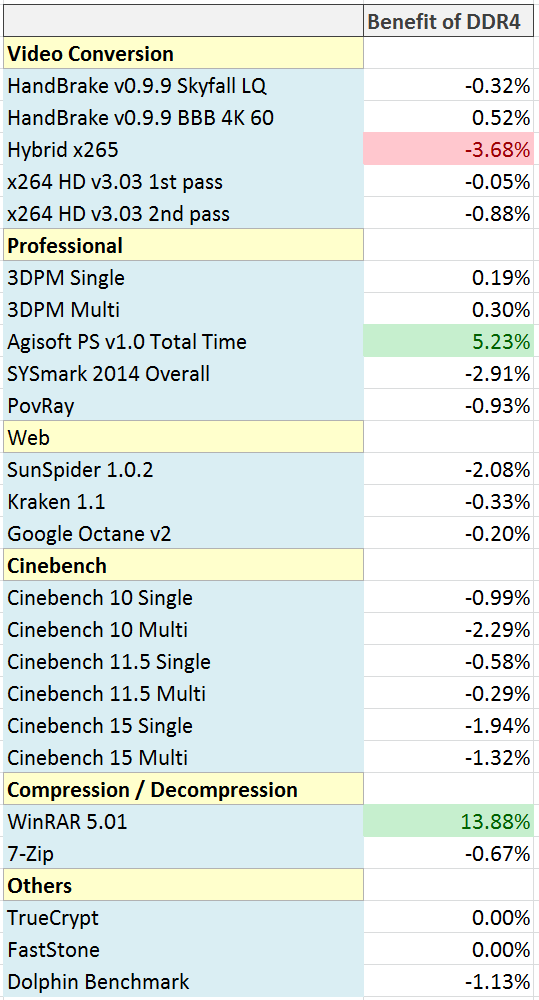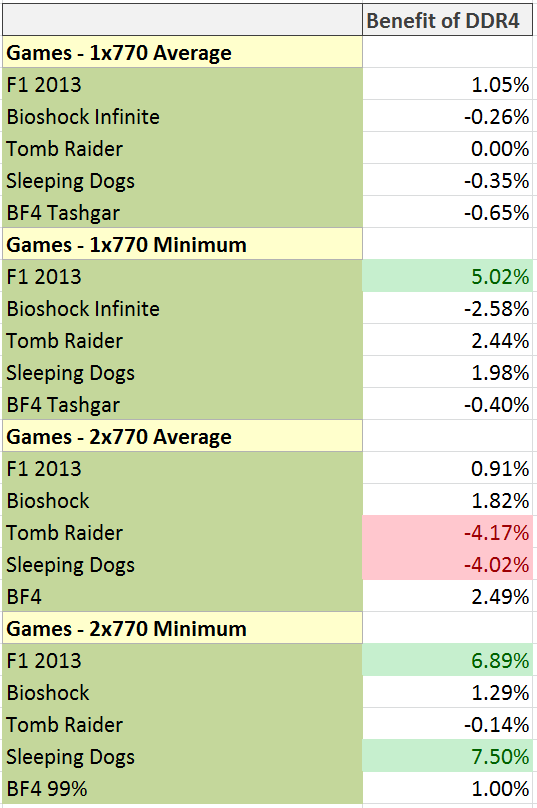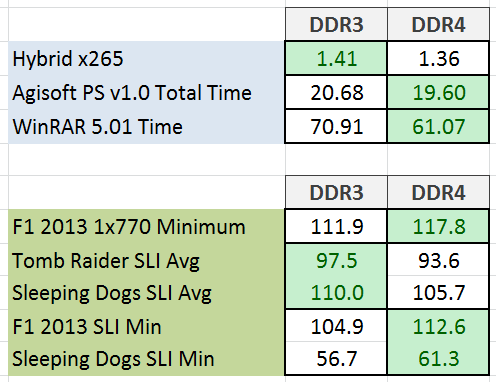DDR4 Haswell-E Scaling Review: 2133 to 3200 with G.Skill, Corsair, ADATA and Crucial
by Ian Cutress on February 5, 2015 10:10 AM ESTComparing DDR3 to DDR4
Moving from a standard DDR3-2133 C11 kit to DDR4-2133 C15, just by looking at the numbers, feels like a downgrade despite what the rest of the system is. Ideally we want the first number, the frequency, to be high and the second number, the latency, to be low. After spending several years dealing with DDR3, moving to DDR4 feels a bit of a backwards step when you look at solely the numbers on paper.
As part of this review we have covered many different areas where DDR4 is the upgrade of DDR3, not only in terms of voltage but some of the underlying concepts as well. This puts DDR4 in a position for upgradability in the future, especially when it comes to density and future technologies (see the next page for more information). But an ultimate question still remains: at the same frequency and latency, do they perform the same?
The only way to perform an identical comparison would be to have a platform that could probe both DDR3 and DDR4 while keeping the same CPU. If one comes along, we will test that, but in the mean time we can do some broad comparisons with near-identical systems.
For this test we took two Haswell based systems and compared them against each other. The first contains the Haswell-E i7-5960X processor, cut it down to run at four cores with no HyperThreading, fixed the CPU speed at 4 GHz and placed the memory into DDR4-2133 14-14-14 350 2T timings. We did the same with the second system, a Haswell based i7-4770K moved it to 4 GHz and making sure it was in 4C/4T mode. The OS was placed into a unique high performance profile and we ran our test suite. The only difference that remained between the two setups was the L2 and L3 cache, which we cannot change unfortunately.
In our non-gaming tests, there is one situation where DDR3 is more than 3% better and two where DDR4 is +3%. It is worth noting that most of the numbers, especially with things like the Web and Cinebench are actually slightly negative.
In the gaming tests, similarly there are more +3% on the side of DDR4. If we do a direct comparison regardless of the percentage, DDR4 wins 11 times compared to DDR3 getting 8, and almost of DDR3’s wins are minor except for two-way SLI. It would seem that for two-way SLI DDR4 at least brings up some of the minimum frame rates.
Pulling out the >3% difference numbers, just to see what the numbers exactly are:
On the face of it, the Hybrid result does not seem that different, whereas a full minute on Photoscan or 10 seconds in our WinRAR test feels like a difference. In the gaming tests moving nearer to 120 FPS or 60 FPS, especially in both of the minimum frame rate tests, is an important jump which happens with DDR4.
Overall, comparing DDR4 to DDR3, there is little difference to separate the two. In a couple of small instances one is better than the other, but on those edge cases it might be prudent to say that we cannot make a final decision until we can synchronize the rest of the system, such as the size of CPU caches. When we can perform such tests, we will run some more numbers.













120 Comments
View All Comments
Harry Lloyd - Friday, February 6, 2015 - link
So no difference whatsoever no matter which test? Not surprising, considering the quad channel controller.I hope to see a similar test when dual channel Skylake comes out. Also, please find some CPU-bound games. BioShock, Tomb Raider and Sleeping Dogs do not need more than two cores, which makes them completely pointless for this kind of test. Try games like Battlefield 4 MP or Dying Light (extremely CPU-bound and easy to repeat).
Arbie - Friday, February 6, 2015 - link
@nwrigley - I also agree. I have a 2008 build using a Yorkfield quad at 3.6GHz, still running 32-bits and the original 4GB of DDR2. The three things I have really needed to add since then are SSDs, a new graphics card (expected), and adapters for USB3 ports. All of these are "bolt-on", not fundamental changes, and the only one I researched was the gfx board. I know a Haswell build would be 2x more powerful and run much cooler, but neither of those justifies a system replacement. I almost never max out the CPU, or even the RAM.This "good enough" syndrome is obviously affecting the industry, and even the websites dealing with it. One well established and very good equipment review site has recently gone, probably because too few people still care about small differences in desktop motherboard, PSU, DRAM, and cooler performance. I suppose this trend will continue.
jabber - Friday, February 6, 2015 - link
I have to admit I stopped looking seriously at RAM reviews once we hit DDR2. I wince when I see a reviewer has wasted a week of their life to do a DDR3 'performance' RAM round up. Well thanks for telling us AGAIN that there is a performance difference of 2% or 0.5FPS between stock $50 RAM and the $300 top of the range. Why do they keep doing RAM group tests?nwarawa - Friday, February 6, 2015 - link
It wasn't very clear, but it sounded like the ddr3/4 comparison was dual channel vs quad channel. A better apples to apples test would run the x99 system is dual channel.halcyon - Friday, February 6, 2015 - link
TL;DR: Does NOT scale.The price difference between 2133 and any of the higher speeds makes no sense, unless you are a super-high res competitive pro-gamer or if you run real-time intensive huge dataloads 24/7.
For even heavy users, workstations, etc - no point. Just buy the most reliable 2133 or 2400 that is the cheapest.
Last graph is horrible, baseline doesn't start from zero. Differences are minimal.
Sad is the day when the element of interest for pro users is : "Firstly is the design, and finding good looking memory".
jnkweaver - Friday, February 6, 2015 - link
So for example, when given DDR3-2133 C10 (PI of 213) against DDR3-1866 C10 (PI or 187), the first one should be chosen. However with DDR3-2133 C10 (PI of 213) and DDR3-2400 C12 (PI of 200) at the same price, the results would suggest the latter is a better option.So 213 beats 187 (1st example) but 213 doesn't beat 200? (2nd example)
Wwhat - Saturday, February 7, 2015 - link
So from the looks of the tests the speed absolutely makes no difference, but now what I'm wondering is what happens if you have many things running at the same time, several programs simultaneously, maybe that will bring some differences to light? Or is there really no difference at all? That seems a bit odd, and a flaw in the CPU design since it can't utilize the extra speed. The RAM speed is suppose to be a bottleneck for the CPU after all.Maybe we should hear some comments on the subject from intel and AMD.
DarkXale - Saturday, February 7, 2015 - link
Its not at all a flaw; on the contrary its all about intelligently predicting what data we need to have access to soon.gsuburban - Saturday, February 7, 2015 - link
DDR4 is not that much a performance change and 4 times the cost so, DDR3 will still be around.It's overpriced RAM in the least.
YoloPascual - Sunday, February 8, 2015 - link
DDR4 = half doa tech